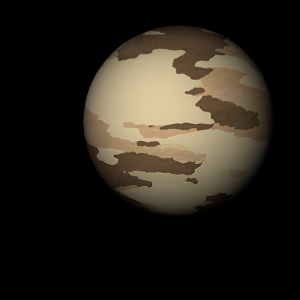|
|
Space Astro
|
Info for exoplanet "Tungr Gellin"
| Scientific (actual) data |
|---|
| Name | Kepler-90 f |
| Planet status | Confirmed |
| Radius | 0.257 |
| Orbital period | 124.914 |
| Semi major axis | 0.48 |
| Orbit eccentricity | 0.01 |
| Inclination | 89.77 |
| Discovered | 2013 |
| Updated | 2021-11-27 |
| Tconj | 2455090 |
| Tzero tr | 2455090 |
| Impact parameter | 0.35 |
| Temperature (kelvin) | 592 |
| Publication | Published in a refereed paper |
| Detection type | Primary Transit |
| Alternate names | KOI-351 f, KIC 11442793 f, 2MASS J18574403+4918185 f, K00351.07, KOI-351.07, Kepler-90 f, WISE J185744.03+491818.5 f |
| Star name | Kepler-90 |
| Right ascension | 284.43° |
| Declination | 49.31° |
| Mag v | 14 |
| Mag j | 12.79 |
| Mag h | 12.531 |
| Star distance | 780 |
| Star metallicity | -0.12 |
| Star mass | 1.2 |
| Star radius | 1.2 |
| Star temperature | 6080 |
| Star alternate names | KOI-351, 2MASS J18574403+4918185, KIC 11442793, WISE J185744.03+491818.5 |
| Wikipedia article | Kepler-90 f |
Back
| |
| Fictional info (?) |
|---|
| Suggested name | Tungr Gellin |
| Planet type | Cold planet |
| It is a cold planet planet with a mass one-thousandth that of Kepler-90, but two-and-a-half times that of all the other planets in its solar system combined.
The surface is said to have friendly but shy terraformed herbivores called the "Skoll De". They spend their life by seeking another species called Dusxige They are somewhat related to the Hionn but have 3 eyes and vary in size from 50 to 80 meters. They can endure temperatures from 0 to 50°C but are killed by severe infection. |
| Estimated population | 70000000000 |
| Atmosphere | Oxygen | 81% |
| Water | 10% |
| Carbon dioxide | 8.8% |
| Methane | 0.021% |
| Atmospheric pressure | 1.4 bar |
 |
| Moon | Bian | Small round ice moon |
| Epiqeq Dita Si | Medium-sized potato shaped crater-filled moon |
| Palkal | Huge slightly egg-shaped crater-filled asteroid |
| Sebiteus | Large slightly egg-shaped rocky asteroid |
| Epilia | Very small almost round rocky moon |
| Malskaa-te | Small round ice comet |
| Hergaret Cyl | Small slightly egg-shaped crater-filled planetoid |
| Medeia Ancal Li | Small slightly egg-shaped oceanic asteroid |
| Loge Maka-paliaq | Medium-sized slightly egg-shaped rocky moon |
| Kacaliet Sie | Huge almost round crater-filled moon |
| Phaë Pan | Small potato shaped gaseous asteroid |
| Dusidipid | Huge potato shaped rocky asteroid |
| Bestcho | Small round gaseous comet |
| Bedilorix | Medium-sized irregular rocky moon |
| Tiagala | Huge round gaseous asteroid |
| Tonpero-qeq | Large almost round rocky asteroid |
| Hionn-noeti | Large almost round rocky moon |
| Rokano'thy | Very small potato shaped rocky asteroid |
| Thyobe Teus Sete | Huge slightly egg-shaped gaseous moon |
| Lenerosa Mas | Huge almost round rocky comet |
| Google search for Tungr gellin |
|
Website by Joachim Michaelis
|
|
|
|